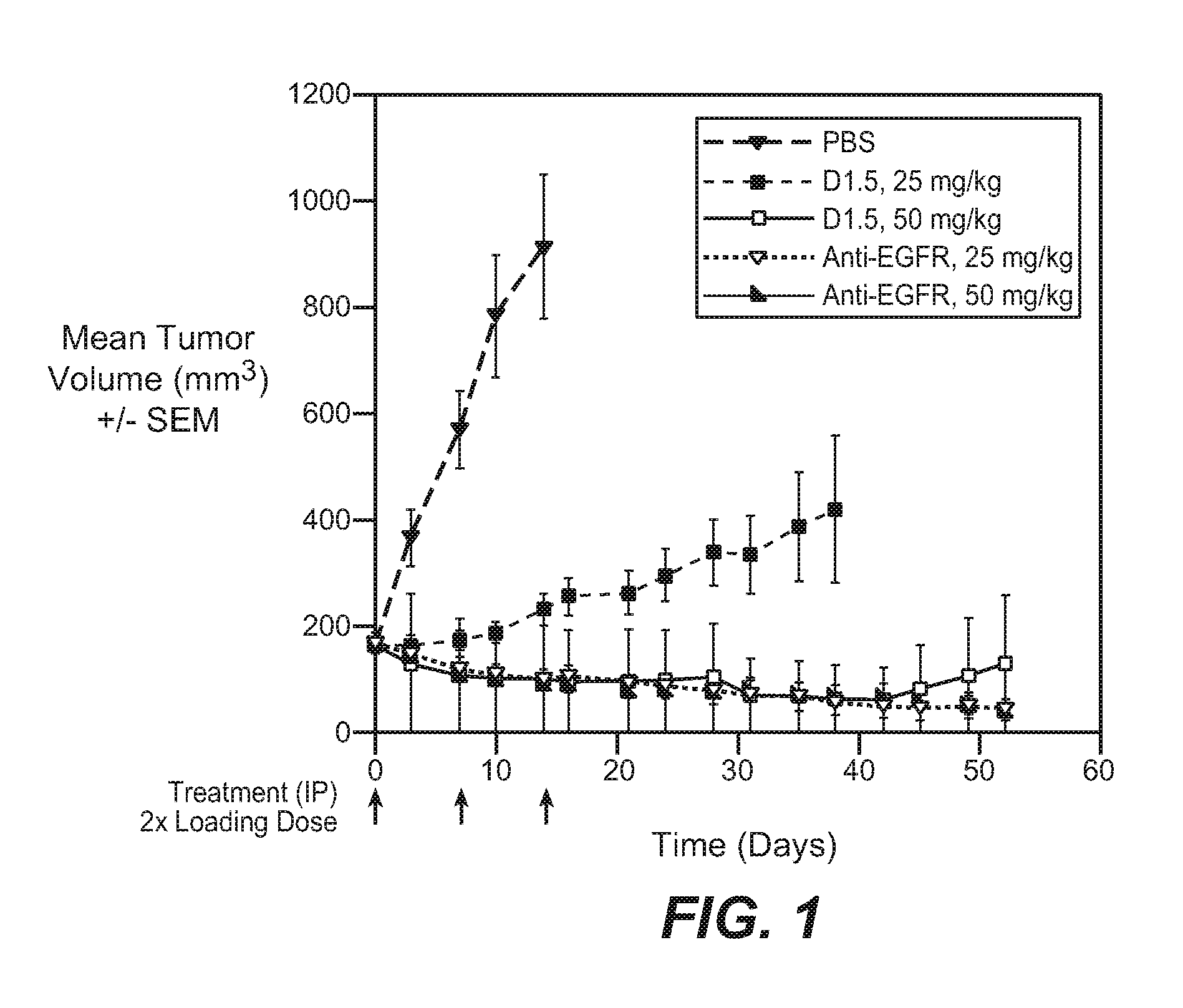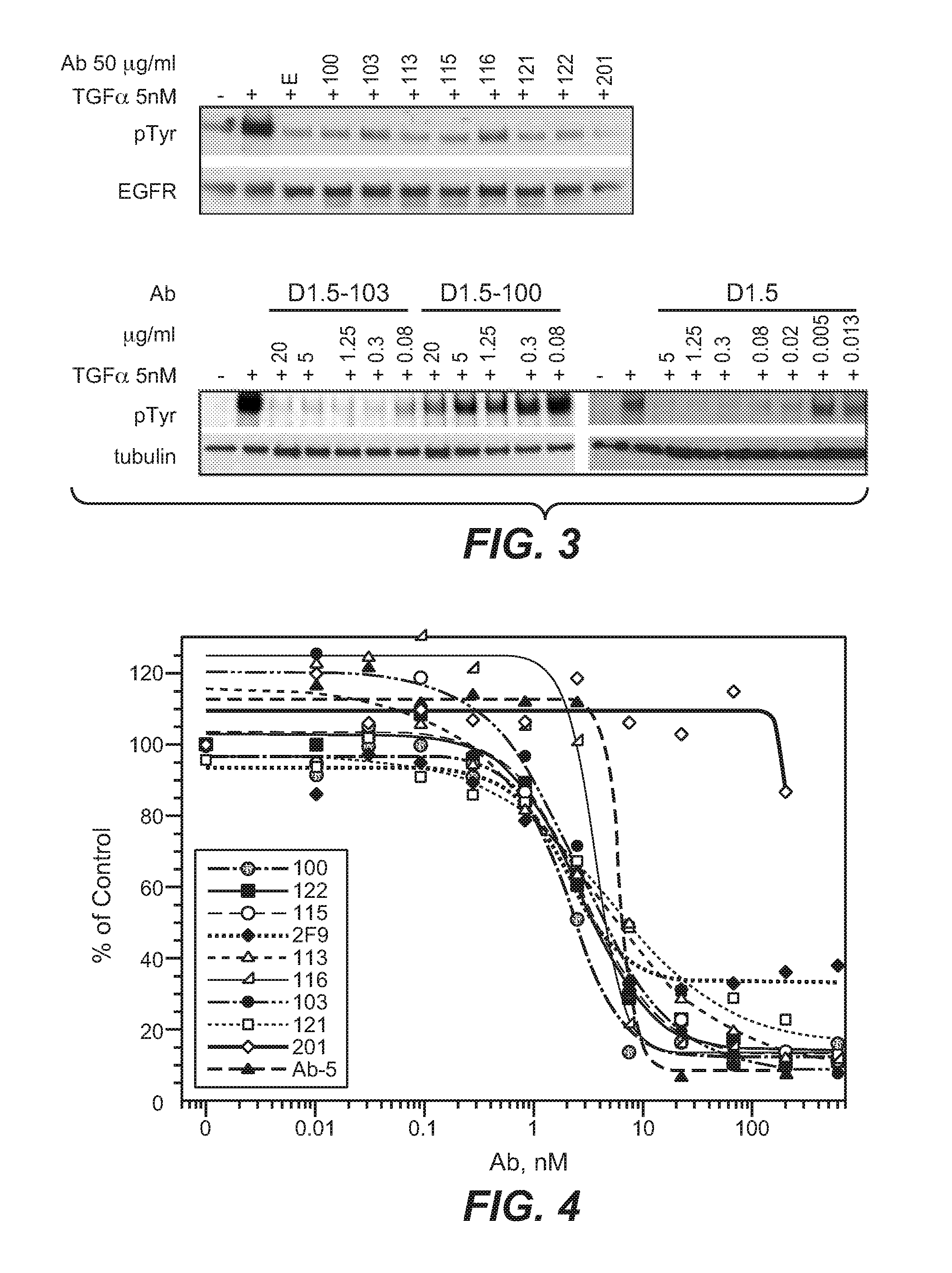Bispecific Anti-her antibodies
a technology of her1 and anti-her antibodies, applied in the field of anti-her antibodies, can solve the problems of affecting the effect of skin toxicity,
- Summary
- Abstract
- Description
- Claims
- Application Information
AI Technical Summary
Benefits of technology
Problems solved by technology
Method used
Image
Examples
example 1
Isolation and Characterization of Antibodies Binding Human EGFR
Materials
[0334]Enzymes and M13-KO7 helper phage were purchased from New England Biolabs. E. coli XL1-Blue was from Stratagene. Bovine serum albumin (BSA), ovalbumin, and Tween 20 were purchased from Sigma. Neutravidin, casein and Superblock were purchased from Pierce. anti-M13 conjugated horse-radish peroxidase (HRP) was purchased from Amersham Pharmacia. Maxisorp immunoplates were purchased from NUNC (Roskilde, Denmark). Tetramethylbenzidine (TMB) substrate was purchased from Kirkegaard and Perry Laboratories (Gaithersburg, Md.).
Library Construction
[0335]Phage displayed antibody libraries were generated based on human antibody framework from humanized 4D5 (h4D5, trastuzumab), where side chain and length diversity were incorporated into heavy chain complementarity determining regions (CDR1, CDR2, CDR3) in the first library (Library 1), and into heavy chain CDRs and light chain CDR3 in the second library (Library 2) still...
example 2
Characterization of antibodies against human Epidermal Growth Factor Receptor
Inhibition of Ligand Binding
[0353]order to determine if selected anti-EGFR antibody D1 inhibits 125I-EGF binding to H1666 cells (ATCC CRL-5885, Manassas, Va.), the purified IgGs version of D1 was tested in a ligand binding assay as follows. H1666 cells were plated in 12 well plates. The next day growth medium was removed and cells were pretreated with 200 nM antibody for 2 hours at room RT. 20 μl / well of radiolabelled EGF was added (use conc. below Kd of cell line) and cells were treated for an additional 2 hours at room temperature. Cells were washed with binding buffer and solubilized, transferred and samples were counted using an iso Data γ-counter. Unlabelled EGF was used as a cold competitor. The results demonstrate that D1 inhibits 125I-EGF ligand binding to H1666 cells.
Inhibition of TGF-α induced EGFR Phosphorylation in Stably Transfected EGFR-NR6 Cells
[0354]To determine if anti-EGFR antibody D1 sele...
example 3
Affinity Maturation of D1
Library Construction
[0355]Two phage-displayed libraries (L3 / H3 and L3 / H1H2 libraries) were created using oligonucleotide-directed mutagenesis as described (Lee et al., Blood, 108, 3103-3111, 2006). The library template vectors contained a stop codon (TAA) embedded in CDR-L3, which was repaired during the mutagenesis reaction using degenerate oligonucleotides that annealed over the sequences encoding CDR-L3 (all libraries), CDR-H3 (L3 / H3 library), CDR-H2 and CDR H1 (L3 / H1H2 library). The library mutagenesis reactions were performed according to the method of Kunkel et al (Methods Enzymol. 1987; 154:367-82). The oligonucleotides were combined in different ratios to fine-tune the diversity to reflect the amino acid frequency in natural repertoire at selected positions. The mutagenesis products were pooled into one reaction per library and electroporated in to E. coli SS320 cells and grown supplemented with KO7 helper phage as described (Lee et al., 2004, supra)...
PUM
| Property | Measurement | Unit |
|---|---|---|
| dissociation constant | aaaaa | aaaaa |
| dissociation constant | aaaaa | aaaaa |
| dissociation constant | aaaaa | aaaaa |
Abstract
Description
Claims
Application Information
 Login to View More
Login to View More - R&D Engineer
- R&D Manager
- IP Professional
- Industry Leading Data Capabilities
- Powerful AI technology
- Patent DNA Extraction
Browse by: Latest US Patents, China's latest patents, Technical Efficacy Thesaurus, Application Domain, Technology Topic, Popular Technical Reports.
© 2024 PatSnap. All rights reserved.Legal|Privacy policy|Modern Slavery Act Transparency Statement|Sitemap|About US| Contact US: help@patsnap.com










